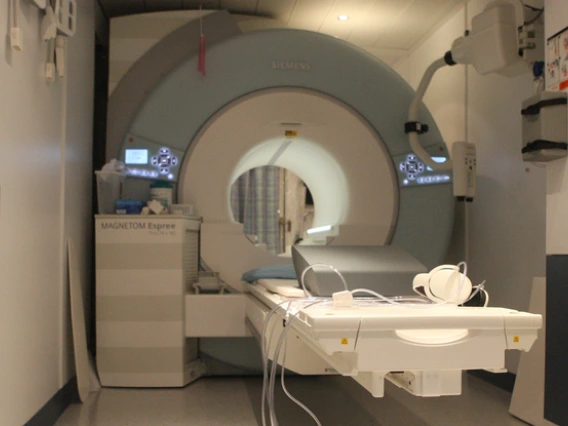U of A launches AI-powered MRI systems
University professors and community leaders gather to celebrate the installation of two advanced MRI machines.

(From left) Vignesh Subbian, associate professor of systems and industrial engineering; Katie Grant, vice president of magnetic resonance for Siemens Healthineers; Tomás Díaz de la Rubia, senior vice president for research and partnerships at the University of Arizona; CJ Karamargin, adviser to Congressman Juan Ciscomani; and Lee Ryan, professor of psychology, inaugurate two imaging systems on Sept. 3, 2025.
Deanna Rodriguez, BIO5 Institute
University of Arizona researchers now have the tools to conduct advanced medical imaging studies after a pair of MRI systems were installed on campus earlier this year. Campus leadership and industry partners commemorated the achievement with a ribbon-cutting ceremony on Sept. 3, 2025.
The machines, powered by artificial intelligence, open possibilities for treating neurological diseases such as Alzheimer's and Parkinson's, as well as expanding the capabilities for imaging the heart, lungs and liver – even for patients with metallic implants.
"These MRI systems represent a strategic investment in technologies that harness artificial intelligence to improve human health," said Tomás Díaz de la Rubia, senior vice president for research and partnerships. "By pairing these state-of-the-art tools with U of A's transdisciplinary expertise, we are accelerating innovation in discovery, diagnosis and treatment. This is how we deliver on the promise of AI-driven health care."
Both MRIs are housed in the Translational Bioimaging Resource, or TBIR, a biomedical imaging lab that serves researchers across the university and is supported by the Office of Research and Partnerships.
Building on that momentum, more than 30 researchers launched the BIO5 Brain & Body Imaging Center, uniting their expertise to maximize use of the technology.
Two MRIs, one bold vision
Two years ago, the National Institutes of Health awarded U of A researchers – led by Ted Trouard, professor emeritus of biomedical engineering in the College of Engineering – a $2 million grant to purchase a Siemens MRI system for brain research. At the time, the university's only research-dedicated MRI system was fully booked, limiting opportunities for studies across campus.
In March 2025, the Siemens MAGNETOM Cima.X 3T – the company's most advanced system for brain imaging – was installed.
Just months later, the Siemens MAGNETOM Free.Max 0.55T, designed to expand the capabilities of whole-body imaging, was added.
"What excites me most is knowing our researchers now have the very best possible MRI equipment so they can generate the best possible data for their studies," said Trouard, also a professor of medical imaging.
AI at the core
Artificial intelligence drives both systems, sharpening images and revealing more detailed patterns.
The Siemens Cima.X 3T captures ultra-high-resolution brain scans faster, shortening patient scan time while researchers collect more data.
One example is a scan that tracks how water moves through brain tissue, helping researchers study connections and changes linked to Alzheimer's, multiple sclerosis, and other neurological conditions.
The center will also train the next generation of imaging scientists and clinicians in the latest technologies and AI-driven methods.
"We are always looking forward in imaging," said Nan-kuei Chen, associate professor of BME and expert in MRI physics. "These new technologies, along with the center, will allow us to expand into musculoskeletal imaging, sleep studies, and multi-modal brain research."


